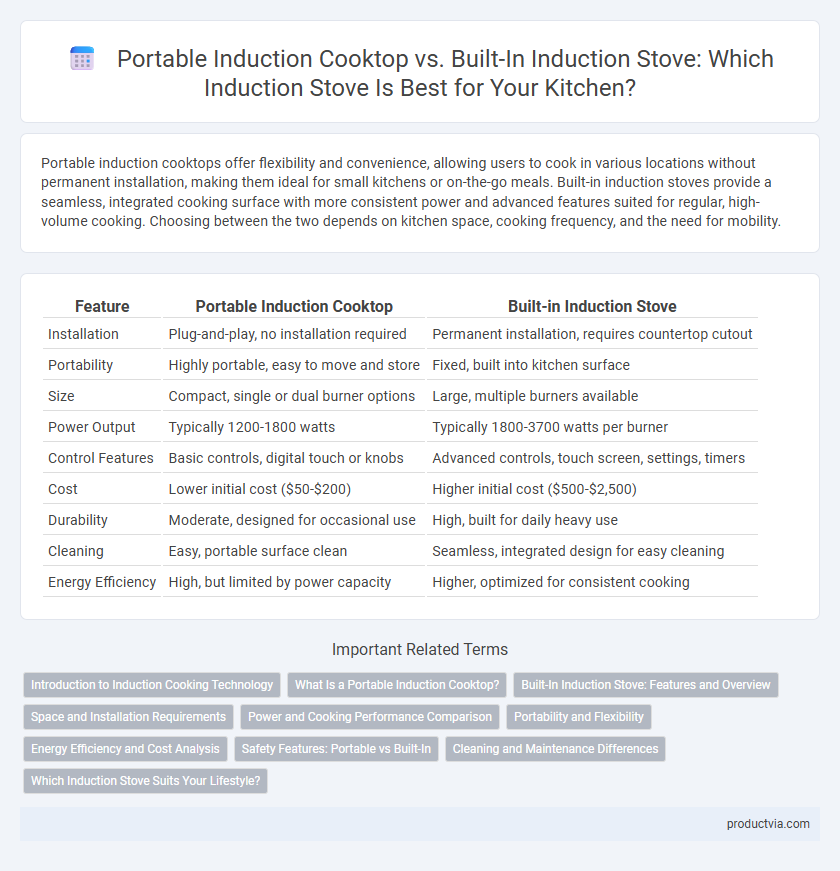Portable induction cooktops offer flexibility and convenience, allowing users to cook in various locations without permanent installation, making them ideal for small kitchens or on-the-go meals. Built-in induction stoves provide a seamless, integrated cooking surface with more consistent power and advanced features suited for regular, high-volume cooking. Choosing between the two depends on kitchen space, cooking frequency, and the need for mobility.
Table of Comparison
| Feature | Portable Induction Cooktop | Built-in Induction Stove |
|---|---|---|
| Installation | Plug-and-play, no installation required | Permanent installation, requires countertop cutout |
| Portability | Highly portable, easy to move and store | Fixed, built into kitchen surface |
| Size | Compact, single or dual burner options | Large, multiple burners available |
| Power Output | Typically 1200-1800 watts | Typically 1800-3700 watts per burner |
| Control Features | Basic controls, digital touch or knobs | Advanced controls, touch screen, settings, timers |
| Cost | Lower initial cost ($50-$200) | Higher initial cost ($500-$2,500) |
| Durability | Moderate, designed for occasional use | High, built for daily heavy use |
| Cleaning | Easy, portable surface clean | Seamless, integrated design for easy cleaning |
| Energy Efficiency | High, but limited by power capacity | Higher, optimized for consistent cooking |
Introduction to Induction Cooking Technology
Induction cooking technology uses electromagnetic fields to heat cookware directly, providing faster and more efficient cooking compared to traditional gas or electric stoves. Portable induction cooktops offer flexibility and easy storage, ideal for small kitchens or temporary setups, while built-in induction stoves deliver seamless integration and a sleek design suited for permanent kitchen installations. Both types rely on compatible ferromagnetic cookware for optimal performance and energy efficiency.
What Is a Portable Induction Cooktop?
A portable induction cooktop is a compact, standalone cooking device that uses electromagnetic fields to heat cookware directly, offering precise temperature control and energy efficiency. Unlike built-in induction stoves, it can be easily moved and used in various locations, making it ideal for small kitchens, dorm rooms, or outdoor cooking. Portable induction cooktops often feature digital displays, touch controls, and safety mechanisms such as automatic shut-off and overheat protection.
Built-In Induction Stove: Features and Overview
Built-in induction stoves integrate seamlessly into kitchen countertops, offering precise temperature control with advanced digital touch controls and multiple heating zones for versatile cooking. These units feature sleek glass-ceramic surfaces, rapid heating technology, and safety mechanisms such as auto shut-off and child lock functions. Designed for permanent installation, built-in induction stoves enhance kitchen aesthetics while delivering energy-efficient performance and consistent cooking results.
Space and Installation Requirements
Portable induction cooktops offer compact designs ideal for small kitchens, dorm rooms, or limited counter space without requiring permanent installation. Built-in induction stoves demand precise cutouts in countertops, professional installation, and adequate ventilation, making them suited for spacious kitchens with planned layouts. The portable option allows flexible use and easy storage, while built-ins provide a seamless, integrated cooking surface that maximizes kitchen aesthetics.
Power and Cooking Performance Comparison
Portable induction cooktops typically offer power ranges from 1200 to 1800 watts, providing efficient cooking for small to medium meals, while built-in induction stoves deliver higher power output, often exceeding 3000 watts, enabling faster heating and support for multiple burners simultaneously. Built-in models offer superior cooking performance with more precise temperature control and consistent power distribution, making them ideal for complex culinary tasks. The portability of cooktops compromises some power capacity, but they remain effective for everyday cooking with energy-efficient heating technology.
Portability and Flexibility
A portable induction cooktop offers unmatched portability, allowing users to move and store the device easily, ideal for small kitchens, outdoor cooking, or temporary setups. Built-in induction stoves provide a permanent installation that maximizes countertop space and integrates seamlessly into kitchen design but lack the flexibility to be relocated. Portability and flexibility are key advantages of portable cooktops, while built-in models prioritize stability and long-term use.
Energy Efficiency and Cost Analysis
Portable induction cooktops typically consume less energy during operation due to their smaller cooking surface and targeted heating, making them more energy-efficient for single or small meal preparation. Built-in induction stoves generally have higher upfront costs, including installation fees, but offer long-term savings through advanced energy efficiency features and higher power settings suitable for larger households. When analyzing costs, portable units provide affordability and flexibility, while built-in models deliver value through durability and potential energy savings in extensive use.
Safety Features: Portable vs Built-In
Portable induction cooktops often include automatic shut-off and overheating protection but may lack advanced child safety locks found in built-in induction stoves, which typically feature pan detection technology and more robust touch control locks. Built-in models offer enhanced safety with integrated sensors that prevent accidental activation and maintain consistent temperature control, reducing the risk of burns and fire hazards. The fixed installation of built-in units also minimizes the risk of tipping or spills compared to the more mobile portable options.
Cleaning and Maintenance Differences
Portable induction cooktops feature smooth glass surfaces that allow for quick wiping with a damp cloth, making cleaning simple and convenient after each use. Built-in induction stoves often require more thorough maintenance due to integrated designs, including care around seams and controls to prevent debris buildup. Removable parts in portable units typically facilitate easier upkeep, whereas built-in models demand careful attention to installation areas and ventilation for optimal performance.
Which Induction Stove Suits Your Lifestyle?
A portable induction cooktop offers flexibility for small spaces and ease of storage, making it ideal for renters or those with limited kitchen space. Built-in induction stoves provide a sleek, permanent installation with larger cooking surfaces and advanced features suited for avid home cooks. Choosing between the two depends on your kitchen layout, cooking habits, and the need for mobility or integrated design.
Portable induction cooktop vs built-in induction stove Infographic

 productvia.com
productvia.com